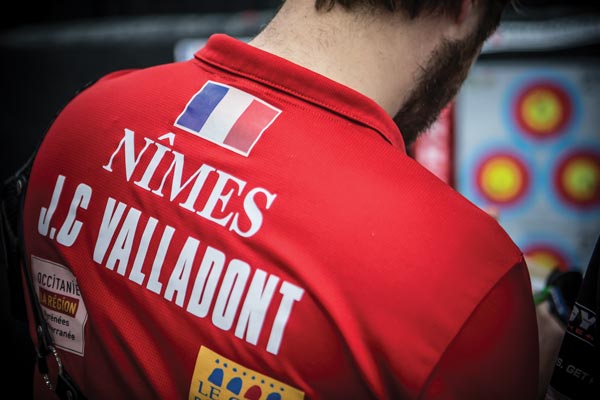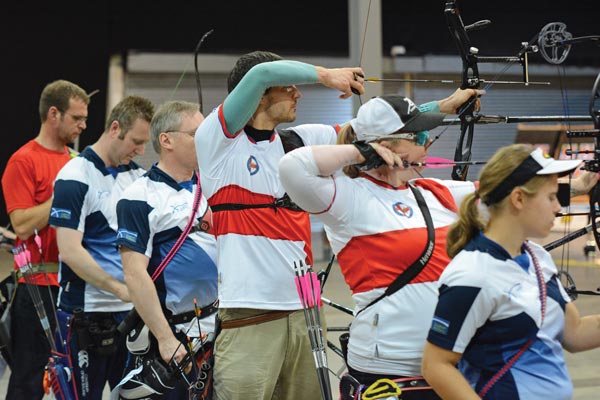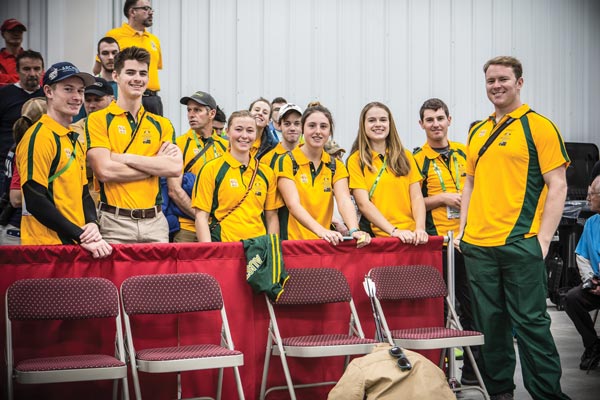Chris Wells thinks your archery club needs a Premier League. Here’s why.

JC Valladont wears his sponsored club shirt proudly in Las Vegas
The term professional is more liberally spread around in archery more than in any other sport I am aware of. Sponsored archers of any level are often referred to as pro staff (and some manufacturers even allow these branded garments for purchase) even though their income from the sport may be minimal. Every modern sport has a professional tier – it’s what those toiling to improve aspire to reach, and there are athletes that make a real living from archery.
But while events like the Hyundai Archery World Cup and the few big-money tournaments around the globe (like Vegas) support the very best in the world, allowing them to shoot and compete without having an alternative day job, the professionalism in archery should actually be coming from a completely different place.
Clubs
Every club should have an ‘A Team’, a top squad that wears a special shirt that identifies them as the best on offer. There are clubs that do this now – like Nimes in the south of France, and ‘Bundesliga’ sides in Germany that also pay athletes a small stipend to represent them. Competition breeds success, and even if that named team never travels to a tournament, it’s still something other club members can aspire to reach.
If one club announces its team at the start of the outdoor (or indoor) season, it’s a nice step in professionalising that club. If two teams in the same area do it, it’s a rivalry. If three – four, many more, have squads, it’s a league. Then imagine that mentality filtering up to the national level. This is a case of ‘egg before chicken’, but it’s something that’s quite simple to achieve. Setting a requirement for application to that squad – say a few 70-metre rounds, availability for one important event – and a selection committee is all that’s needed. You might ask, why go to the trouble? What is the difference between this, and the club members who do travel in shirts? The reason is what comes next.

You need more than just club shirts to inspire from the bottom up
Sponsors
I’ve often heard it said that archery needs non-endemic sponsors (i.e. sponsors who are not directly archery-related). However, I don’t think there is really any such thing as a non-endemic sponsor. A sponsor or an advertiser doesn’t give their money to a sport just because they like it, but they expect to see return on their investment in the form of interest, sales and – ultimately – money in the bank. McDonalds was a long-time sponsor of the Olympic Games; the company doesn’t make sports gear or clothes, but was an ‘endemic’ sponsor from the point of view of the large audience it reached.
On a smaller level (e.g. a club level) McDonald’s isn’t likely to see value in becoming a sponsor. But what clubs do have, far more than at the national or international level, is a small, captive audience. Bray local butchers are more likely to pay for Bray Archery Club’s team shirts than a national company, because if those very shirts make it into the local paper then there’ll be that return. From an audience perspective, rather than a sport perspective, that is endemic. Of course, there will be obstacles. It requires the opportunity to be sold, and a willing partner – and then someone to promote the team, but these are not roles that need to take a huge amount of time to begin with. With small steps, that club team can start its road to professionalism.
Making the ‘A team’
All you need to name a club team is:
A willing club!
A selection committee – 3 people?
A selection procedure – scores?
A place to announce it – clubhouse?
A team structure, which might be partly defined by competition – 3 recurve, 3 compound? Mixed genders? You decide!
Stars
Usain Bolt did not become famous when he won his first Olympic title in Beijing. He was known locally and garnered huge attention at the high-school level in Jamaica, then regionally before he dominated internationally as a junior, all years before his incredible period at the very peak of the sport until retirement in 2017. Sports stars are created from the ground up, not from the top down. Having a team creates stars in your own club, who can be used to inspire new members and create a culture of improvement. How those stars grow from there relies on other things, not least personality and results, but with enough starting the journey, some will reach the destination.

Australian indoor team on tour. The prospect of making the national ‘A’ team is a powerful driver to improve.
The future
Archery is an individual sport. Even when shooting in a team round, there’s nobody that can affect where that arrow lands except you, on the line. This makes it incredibly difficult to empathise with those who compete at the highest level. The vast majority of people around the world understand what it is like to kick or push something, be it a ball, a bottle or stone – and thus following football is easy. It’s one reason that the sport is so popular, and the teams and players within it are so well followed. But just because we don’t kick around an arrow doesn’t mean that the team principle can’t be followed to the extreme – and that the communities that follow those archery teams won’t react with the same pride when their squad sees success.
Internationally, it’s already happening. France has its club-orientated national league, as does Germany; Korean recurve archery is built around professional company teams; in Colombia, there’s a yearly national games where regions compete across all sports; and the recently-announced Indoor Archery World Series will feature a team event in the style of the Formula 1 manufacturer’s championship, open to all kinds of organisations (including clubs). You don’t need to wait for a similar league to open at home, start small – and name your A Team today.
A-Teams in other sports
The structure of a team varies widely, but all are points of inspiration, products for sponsorship and something for supporters to get behind.
Football – 11 players, from very amateur to professional level, representing towns, villages, cities
Formula 1 – 2 drivers, representing a company
NFL – 70+ players, representing a city as a franchise
Americas Cup – boat team representing a boat club, supported by major companies and/or national team
This article originally appeared in the issue 124 of Bow International magazine. For more great content like this, subscribe today at our secure online store www.myfavouritemagazines.co.uk

